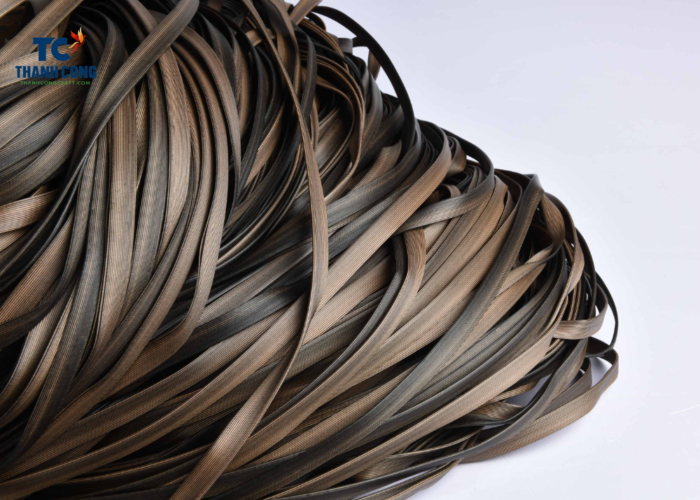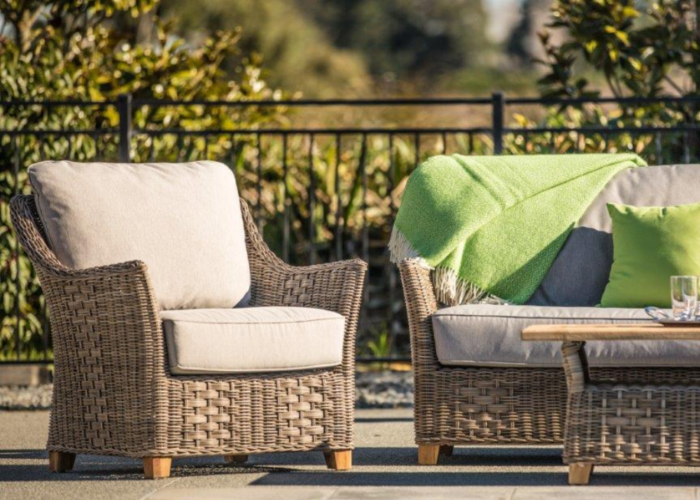Wicker is a type of material made from plant fibers or synthetics, woven into various furniture such as baskets, chairs, tables, or decorative items. Wicker can be synthetic plastic or natural rattan fiber. So, how to tell if wicker is synthetic?
In this guide, we’ll explore the key characteristics and techniques to help you distinguish between synthetic and natural wicker. By understanding the telltale signs and conducting simple tests, you’ll be equipped to make informed decisions when selecting wicker products for your home.
Contents
1. What is synthetic wicker?
Synthetic wicker, also known as resin wicker or all-weather wicker, is a man-made material designed to mimic the appearance and texture of natural wicker while offering greater durability and weather resistance. It is typically made from synthetic fibers such as polyethylene (PE) or polypropylene (PP), which are woven together to create the characteristic wicker pattern.
You may see some other names such as resin wicker, all-weather, poly, polyethylene, vinyl, plastic, faux wicker…
Unlike natural wicker, which is made from plant fibers such as rattan or cane and can be prone to damage from moisture, sunlight, and pests, synthetic wicker is resistant to these elements. This makes it ideal for outdoor furniture, such as patio sets, where it can withstand exposure to rain, sunlight, and temperature fluctuations without deteriorating.
Additionally, synthetic wicker requires minimal maintenance and can be easily cleaned with soap and water, making it a practical choice for outdoor use.

2. How to tell if wicker is synthetic?
Determining whether wicker is synthetic or natural can sometimes be challenging, but there are several methods you can use to help you identify synthetic wicker. Here are some simple methods you can apply:
- Color Examination: Natural wicker often displays uneven colors, ranging from light yellow to dark brown, depending on the plant type and processing method. Synthetic wicker typically has a uniform and more vibrant color, thanks to a protective layer of paint or adhesive.

- Texture Inspection: Natural wicker tends to have a soft, flexible texture that doesn’t easily break when bent. Synthetic wicker is generally stiffer, drier, and more prone to breaking when excessively bent.
- Pattern Observation: Natural wicker commonly exhibits irregular, undulating patterns that lack uniformity. Synthetic wicker tends to have even, straight, and standardized patterns.
- Fire Test: Using a match or a lighter, you can ignite a strand of wicker. If it’s natural wicker, the strand will burn with white or gray smoke, leaving ash. If it’s synthetic wicker, the strand will produce black or green smoke and leave a residue of melted plastic.
- Consider the Environment: If the wicker is intended for outdoor use and is advertised as weather-resistant or all-weather, it is likely synthetic. Natural wicker is more susceptible to damage from moisture, sunlight, and temperature fluctuations.
By considering these factors, you can easily discern whether you’re dealing with natural or synthetic wicker, ensuring you make informed choices for your furniture and decor selections.
2. FAQs
2.1 Is polyethylene wicker toxic?
Polyethylene wicker is a type of plastic used in outdoor furniture. According to some sources, polyethylene wicker is considered one of the safest plastics, as it does not contain harmful substances or formaldehyde found in some other types of plastics.
However, it is still important to pay attention to any additives that may be present in the plastic product and to adhere to the manufacturer’s usage and storage guidelines. Polyethylene wicker is also recyclable, contributing to minimizing its environmental impact.
2.2 How long does synthetic wicker furniture last? is polyethylene wicker durable?
Several factors can influence the lifespan of synthetic wicker furniture, such as the material, quality, design, and maintenance. Generally, synthetic wicker furniture can last from 5 to 15 years, depending on these factors.
One of the most common types of synthetic wicker is polyethylene (PE), a recycled plastic known for its resistance to sunlight, rain, high and low temperatures. PE wicker furniture exhibits high durability, resistance to fading, cracking, or warping.
However, to maintain the freshness and cleanliness of PE wicker furniture, regular cleaning and maintenance are necessary, avoiding exposure to chemicals or fire.
2.3 Is resin wicker waterproof?
Resin wicker is a type of material made from synthetic plastic, offering better water resistance compared to traditional wicker. Resin wicker does not mold, fade, or get damaged by weather conditions. It is also easy to clean and maintain, requiring only a wipe down with water and mild soap. However, resin wicker is not entirely waterproof, only water-resistant.
This means that if left submerged in water for an extended period, it may still deform or lose durability. Therefore, when using resin wicker for outdoor furniture or decor, it is advisable to choose locations with overhead cover or use protective covers to shield it from rain and sunlight.
2.4 Is resin wicker good for outdoors?
Some may think that resin wicker is only suitable for indoor spaces, but in reality, this material can also be used for outdoor areas. Resin wicker is a type of synthetic plastic woven into fibers resembling natural wicker but with higher durability and weather resistance.
It is unaffected by water, sunlight, temperature, and insects, making it easy to clean and maintain. Resin wicker comes in various colors and styles, offering options from classic to modern, simple to intricate. It is an excellent choice for those looking to create a comfortable, elegant, and durable outdoor space.
2.5 Is resin wicker plastic?
Resin wicker is a type of plastic. It is made from synthetic materials such as polyethylene (PE) or polypropylene (PP), which are types of plastics. Resin wicker is often used interchangeably with the term “synthetic wicker” or “all-weather wicker”.
3. Conclusion
In conclusion, determining whether wicker is synthetic requires a keen eye and some knowledge about the materials commonly used in its construction. By examining the texture, color consistency, and flexibility, as well as conducting a burn test if necessary, individuals can make informed decisions about the authenticity of wicker products.
Synthetic wicker offers durability, resistance to weather elements, and often a more affordable price point compared to natural wicker. However, natural wicker exudes a timeless charm and authenticity that some may prefer.
Ultimately, understanding the characteristics of both synthetic and natural wicker empowers consumers to select the option that best suits your needs and preferences.
If you have any further questions, don’t hesitate to send thanhcongcraft an email us at [email protected] or message us at WhatsApp: +84967485411. Hope to serve you soon! Best regard!


